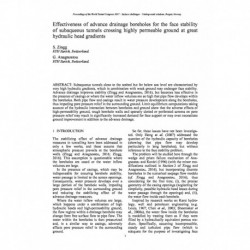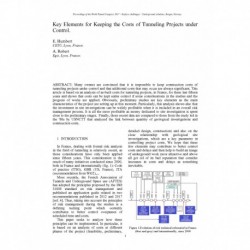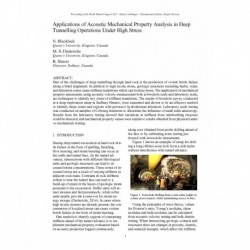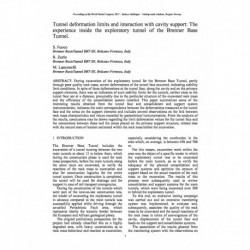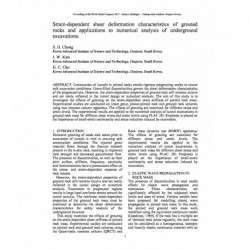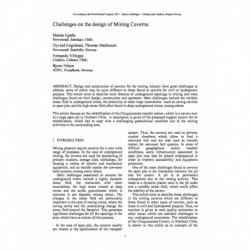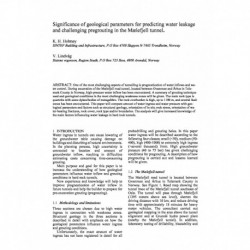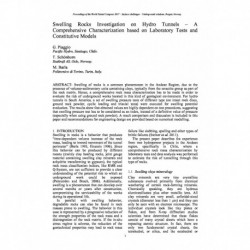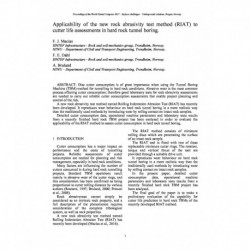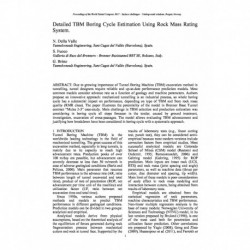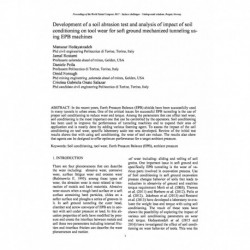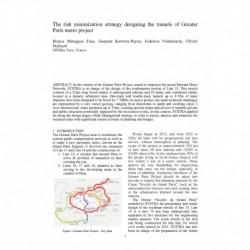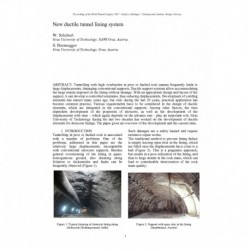No document
Search & filter
Search for a publication
Search & filter
World Tunnelling Congress
WTCThere are 1984 documents.
-
Effectiveness of advance drainage boreholes for the face stability of subaqueous tunnels crossing highly...
Abstract: Subaqueous tunnels close to the seabed but far below sea level are characterized by very high hydraulic gradients, which in combination with weak ground may endanger face stability. Advance drainage improves stability (Zingg and Anagnostou, 2016), but becomes less effective in the presence of casings or where the water inflow volumes are so high that pipe flow develops within the boreholes....
0,00 € -
Key Elements for Keeping the Costs of Tunneling Projects under Control
Abstract: Many owners are convinced that it is impossible to keep construction costs of tunneling projects under control and that additional costs that may occur are always significant. This article is based on an analysis of as-built costs for tunneling projects, in France, for these last fifteen years and shows that costs can be kept under control if some considerations in the studies and the progress...
0,00 € -
Applications of Acoustic Mechanical Property Analysis in Deep Tunnelling Operations Under High Stress
Abstract: One of the challenges of deep tunnelling through hard rock is the prediction of violent brittle failure along a blind alignment. In addition to high in-situ stress, geologic structures including faults, veins, and alteration zones cause stiffness transitions which can localize stress. The application of mechanical property assessment, using acoustic velocity measurement both at borehole scale...
0,00 € -
Tunnel deformation limits and interaction with cavity support: The experience inside the exploratory tunnel of...
Abstract: During excavation of the exploratory tunnel for the Brenner Base Tunnel, partly through poor quality rock mass, severe deformations of the tunnel face occurred, indicating stability limit conditions. In spite of these deformations at the tunnel face, along the cavity and on the primary support elements, there was no indication of such stability limits for the tunnels, neither close to the...
0,00 € -
OREA – Extension of an Existing Sewer Treatment Plant in Strømmen, Norway
Abstract: OREA is the extension of a large underground sewer treatment plant (figure 1), owned by four municipalities outside Oslo. The purpose of OREA is treatment of excess flood water that today runs via a spillway directly out to the Nitelva river. The main rock cavern of OREA will be 60m long, 20m wide and 20-25m deep, rock quality variable and rock overburden shallow. The location is...
0,00 € -
Strain-dependent shear deformation characteristics of grouted rocks and applications to numerical analysis of...
Abstract: Construction of tunnels in jointed rocks entails rigorous pregrouting works to ensure safe excavation conditions. Grout-filled discontinuities govern the shear deformation characteristics of the pregrouted site. However, the strain-dependent properties of grouted rock still remains elusive and are rarely reflected in the tunnel design or numerical analysis. The aim of this study is to...
0,00 € -
Challenges on the design of Mining Caverns
Abstract: Design and construction of caverns for the mining industry have great challenges to address, some of which may be quite different to those found at caverns for civil or hydropower projects. This article aims to describe main features of underground openings in mining and main challenges found on their design, construction and operation. Main challenges include the variable stress field in...
0,00 € -
Significance of geological parameters for predicting water leakage and challenging pregrouting in the Mælefjell tunnel
Abstract: One of the most challenging aspects of tunnelling is prognostication of water inflows and wa- ter control. During excavation of the Mælefjell road tunnel, located between Gvammen and Århus in Tele- mark County in Norway, high-pressure water inflow has been encountered. A summary of grouting technique used and geological conditions in the most challenging weakness zones will be given. The main...
0,00 € -
Swelling Rocks Investigation on Hydro Tunnels – A Comprehensive Characterization based on Laboratory...
Abstract: Swelling of rocks is a common phenomenon in the Andean Region, due to the presence of volcano-sedimentary units containing clays, typically from the smectite group as part of the rock matrix. Hence, a comprehensive rock mass characterization has to be made in order to evaluate the risk of underground works located in this kind of geological environment....
0,00 € -
Applicability of the new rock abrasivity test method (RIAT) to cutter life assessments in hard rock tunnel...
Abstract: Disc cutter consumption is of great importance when using the Tunnel Boring Machine (TBM) method for tunnelling in hard rock conditions. Abrasive wear is the most common process affecting cutter consumption; therefore good laboratory tests for rock abrasivity assessments are needed to carry out reliable cutter consumption assessments that enable project planning and control of the risk. A new...
0,00 € -
Detailed TBM Boring Cycle Estimation Using Rock Mass Rating System
Abstract: Due to growing importance of Tunnel Boring Machine (TBM) excavation method in tunnelling, tunnel designers require reliable and up-to-date performance prediction models. Most common models consider advance rate as a function of geology and machine parameters. Authors propose an innovative approach: mechanized tunnelling is an industrial process, so whole boring cycle has a substantial impact on...
0,00 € -
Project control by using the NTNU model methodology: The new Ulriken Tunnel
Abstract: The Tunnel Boring Machine (TBM) method has become a widely used method for hard rock tunnelling. The use of TBMs involves major investments and high levels of geological risk, furthermore, the method requires accurate predictions of TBM performance and costs in order to facilitate the control of risk and enable projects to avoid delays and budget overruns. During tunnel...
0,00 € -
Development of a soil abrasion test and analysis of impact of soil conditioning on tool wear for soft ground...
Abstract: In the recent years, Earth Pressure Balance (EPB) shields have been successfully used in many tunnels in urban areas. One of the critical issues for successful EPB tunneling is the use of proper soil conditioning to reduce wear and torque. Among the parameters that can affect tool wear, soil conditioning is the most important one that can be controlled by the operators. Soil conditioning has...
0,00 € -
The risk minimization strategy designing the tunnels of Greater Paris metro project
Abstract: In the context of the Greater Paris Project, aimed to empower the actual Parisian Metro Network, SYSTRA is in charge of the design of the southeastern section of Line 15. This stretch consists of a 21km long bored tunnel, 8 underground stations and 25 safety and ventilation shafts, located in a densely urbanized area. One-track and double-track tunnels up to 8.70m of inner diameter have been...
0,00 € -
Investigation of Factor of Safety in Squeezing Ground
Abstract: This paper calculates factor of safety based not only on strength reduction, but also on increasing in-situ stress. It is shown that using strength reduction only, over estimates factor of safety for problems at depth where confining stress is a significant issue. Factor of safety is calculated for a tunnel in squeezing ground. Tunnel convergence and radius of plastic zone are used as the...
0,00 € -
New ductile tunnel lining system
Abstract: Tunnelling with high overburden in poor or faulted rock masses frequently leads to large displacements, damaging conventional supports. Ductile support systems allow accommodating the large strains imposed on the lining without damage. With an appropriate design and layout of the support, it can develop a controlled resistance, thus reducing displacements. Development of yielding...
0,00 €

